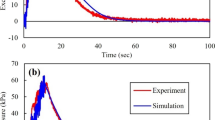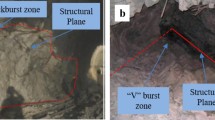Abstract
According to the International Society of Rock Mechanics, squeezing is a time dependent large deformation occurring during tunnel construction around the tunnel associated with creep caused by exceeding a limiting shear stress (Barla in ISRM News J 2:44–49, 1995). This research is conducted using a case study on the Nowsoud Tunnel, Iran. Being 14 km in length and 4.5 m in diameter, the tunnel is located in the western part of Iran near the Iraq border. Nowsoud tunnel, which was excavated using a double shield TBM, exhibited severe squeezing (with 8919 m) in its critical zone which resulted in excavation termination. In this research, the best approach for predicting squeezing among the recommended methods for reducing the damages caused by squeezing on TBM was determined. In this regard, approaches commonly used to predict squeezing are empirical, semi-empirical, and theoretical–analytical methods. Besides, these methods, numerical modeling is used to estimate convergence generated along the tunnel pathways, which is ultimately used to categorize squeezing. This paper compares squeezing prediction methods in 68 section of Nowsoud Tunnel. These 68 sections indicate that the empirical methods propose a general estimation/overview of squeezing. Among the semi-analytical approaches, the one proposed by Hoek and Marinos (Rock engineering in difficult rock conditions—soft rocks and karst, Taylor & Francis Group, London, pp 49–60, 2000) are compatible with the occurrence of squeezing in the critical zone. However, the degree of predicted squeezing is less than the real degree of squeezing in this zone. Based on the result of Aydan approach, 75 % of the tunnel sections are under squeezing condition. Theoretical–analytical approaches underestimate the possibility of squeezing in the critical zone. Barlaʼs approach (1995) demonstrated the possibility of squeezing in the critical zone with low intensity. The numerical computations in this paper were performed using Plaxis (version 8.5), a two-dimensional numerical program based on the finite element method. Plaxis results, classified by Hoek and Marinos (2000) method, show that 8800 m of the tunnel length is under the non-squeezing condition. According to all prediction methods, the squeezing zones depend on faulted zones, argillaceous limestone and shale formations such as J1Kh, J4Kh, J5Kh, and Kgr. These formations were identified with a high quantity of shale and argillaceous limestone. Bedding of these geological formations is thin and their geotechnical properties are weaker than those of limestone formations. On the other hand, non-squeezing zones depend on limestone formations such as J2Kh, J3Kh, J6Kh, Kabg, and Kbg. Moreover, all approaches predicted squeezing potential for the critical zone where TBM is jammed.













Similar content being viewed by others
Notes
Normalized convergence is defined as the percentage ratio of radial tunnel wall displacement to tunnel radius.
References
Aydan O, Akagi T, Kawamoto T (1993) The squeezing potential of rock around tunnels: theory and prediction. Rock Mech Rock Eng 26:137–163
Aydan O, Akagi T, Kawamoto T (1996) The squeezing potential of rock around tunnels: theory and prediction with examples taken from Japan. Rock Mech Rock Eng 29:125–143
Barla G (1995) Squeezing rocks in tunnels. ISRM News J 2:44–49
Barla G (2001) Tunneling under squeezing rock conditions. Euro summer-School in Tunnel Mechanics, Innsbruck. http//www.polito.it/rockmech/Pubblicazioni/Art_convegni/Innsbruck2001.PDF. Accessed 23 Feb 2011
Barla G (2010) Innovative tunneling construction method to cope with squeezing at the Saint Martin La Porte access adit (Lyon–Turin base tunnel). In: Vrkljan I (ed) Rock engineering in difficult rock conditions—soft rocks and karst. Taylor & Francis Group, London, pp 15–24
Barla G, Pelizza S (2000) TBM tunneling in difficult ground conditions. In: GeoEng2000 – An international conference on geotechnical & geological engineering. Melbourne, pp 20
Barton N, Lien R, Lunde J (1974) Engineering classification of rock masses for the design of tunnel support. Int J Rock Mech 4:189–239
Bieniawski ZT (1989) Engineering rock mass classifications. Wiley, New York
Brinkgreve RBJ, Vermeer PA (1998) Plaxis finite element code for soil and rock analyses. Balkema, Rotterdam
Cantieni L, Anagnostou G (2009) The effect of the stress path on squeezing behavior in tunneling. Rock Mech Rock Eng 42(2):289–318
Chern JC, Yu CW, Shiao FY (1998) Tunneling in squeezing ground and support estimation. In: Proceedings of regional symposium on sedimentary rock engineering, Taipei, pp 192–202
Dalgic S (2002) Tunneling in squeezing rock, the Bolu tunnel, Anatolian Motorway, Turkey. Eng Geol 67(1):73–96
Dizaji A, Toudeshki V, Gheidari M (2015) Numerical analysis of boundary conditions to tunnels. Glob J Multidiscip Appl Sci 3(2):37–41
Eberhardt E (2001) Numerical modeling of three-dimensional stress rotation ahead of an advancing tunnel face. Int J Rock Mech Mine Sci 38(4):499–518
Einstein HH (1996) Tunneling in difficult ground-swelling behavior and identification of swelling rocks. Rock Mech Rock Eng 29:113–124
Gioda G, Cividini A (1996) Numerical methods for the analysis of tunnel performance in squeezing rocks. Rock Mech Rock Eng 29:171–193
Goel R, Jethwa J, Paithankar G (1995a) Tunneling trough the young Himalayas—a case history of Maneri-Uttarkashi power tunnel. Eng Geol 39:31–44
Goel RK, Jethwa JL, Paithankar AG (1995b) Indian experiences with Q and RMR systems. Tunn Undergr Space Technol 10:97–109
Hoek E (1994) Strength of rock and rock masses. ISRM News J 2(2):4–16
Hoek E (1998) Tunnel support in weak rock. In: Proceeding of regional symposium on sedimentary rock engineering, Taipei, pp 1–12
Hoek E (1999) Support for very weak rock associated with faults and shear zones. In: Villaescusa E, Windsor C, Thompson A (eds) Rock support and reinforcement practice in mining: proceedings of fourth international symposium on ground support. A.A. Balkema, Rotterdam, pp 19–32
Hoek E (2001) Big tunnels in bad rock. J Geotech Geoenviron Eng 127:726–740
Hoek E, Guevara R (2009) Overcoming squeezing in the Yacambú-Quibor tunnel, Venezuela. Rock Mech Rock Eng 42:389–418
Hoek E, Marinos P (2000) Predicting tunnel squeezing problems in weak heterogeneous rock masses. Tunn Tunn Int 32(11):45–51; 32(12):34–36
Hoek E, Marinos PG (2010) Tunneling in overstressed rock. In: Vrkljan I (ed) Rock engineering in difficult rock conditions—soft rocks and karst. Taylor & Francis Group, London, pp 49–60
Hudson JA (2010) Stresses in rock masses: a review of key points. In: Vrkljan I (ed) Rock engineering in difficult rock conditions—soft rocks and karst. Taylor & Francis Group, London, p 61
Jethwa JL, Singh B, Singh B (1984) Estimation of ultimate rock pressure for tunnel linings under squeezing rock conditions—a new approach. In: Brown ET, Hudson JA (eds) Proceedings of ISRM symposium on design and performance of underground excavations, Cambridge, pp 231–238
Kovári K (1998) Tunneling in squeezing rock. Tunnel 5:12–31
Kovari K, Staus J (1996) Basic considerations on Tunneling in squeezing ground. Rock Mech Rock Eng 29:203–210
Malan DF (1999) Time-dependent behavior of deep level tabular excavations in hard rock. Rock Mech Rock Eng 32:123–155
Malan DF, Basson FRP (1998) Ultra-deep mining: the increased potential for squeezing conditions. J S Afr Inst Min Metall 98(7):353–363
Nogole Sadat M (1988) A review of tectono-sedimentary zonation in Iran; 28 International Geological Congress, Washington, DC, USA
Palmstrom A, Broch E (2005) Use and misuse of rock mass classification systems with particular reference to the q-system. Tunn Undergr Space Technol 21:575–593
Panet M (1996) Two case histories of tunnels through squeezing rocks. Rock Mech Rock Eng 29:155–164
Plaxis 2D Version 8.5 (2006) User manual
Ramoni M, Anagnostou G (2010) The interaction between shield, ground and tunnel support in TBM Tunneling through squeezing ground. Rock Mech Rock Eng 44:37–61
Sahel Consulting Engineers (2010) Report of geological study and engineering geotechnical of Nowsoud tunnel. Unpublished report
Sakurai S (1983) Displacement measurements associated with the design on underground openings. In: Kovári K (ed) Proceedings of international symposium on field measurements in geomechanics. Balkema, Zurich, pp 1163–1178
Schubert W (1996) Dealing with squeezing condition in Alpine tunnels. Rock Mech Rock Eng 29:145–153
Shrestha GL, Broch E (2008) Influences of the valley morphology and rock mass strength on tunnel convergence: with a case study of Khimti 1 headrace tunnel in Nepal. Tunn UndergrSpace Technol 23:638–650
Singh B, Jethwa JL, Dube AK, Singh B (1992) Correlation between observed support pressure and rockmass quality. Tunn Undergr Space Technol 7:59–74
Terzaghi K (1946) Rock defects and loads in tunnel supports. In: Proctor RV, White TL (eds) Rock tunneling with steel supports. The Commercial Shearing and Stamping Co., Youngstown, Ohio, pp. 17–99
Vlachopoulos N, Diederichs MS (2014) Appropriate uses and practical limitations of 2D numerical analysis of tunnels and tunnel support response. Geotech Geol Eng 32(2):469–488
Wiesmann E (1912) Mountain pressure. Switz J Struct 60(7):15 (in German)
Acknowledgments
The authors wish to thank the Coast Institute of Consulting Engineers for their cooperation and assistance in this study. The authors would also like thank Mr. Hassan Mohamadi.
Author information
Authors and Affiliations
Corresponding author
Rights and permissions
About this article
Cite this article
Fatemi Aghda, S.M., Ganjalipour, K. & Esmaeil Zadeh, M. Comparison of Squeezing Prediction Methods: A Case Study on Nowsoud Tunnel. Geotech Geol Eng 34, 1487–1512 (2016). https://doi.org/10.1007/s10706-016-0056-0
Received:
Accepted:
Published:
Issue Date:
DOI: https://doi.org/10.1007/s10706-016-0056-0




